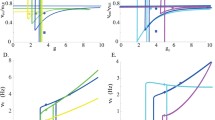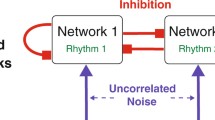Abstract
We discuss the suppression of collective synchrony in a system of two interacting oscillatory networks. It is assumed that the first network can be affected by the stimulation, whereas the activity of the second one can be monitored. The study is motivated by ongoing attempts to develop efficient techniques for the manipulation of pathological brain rhythms. The suppression mechanism we consider is related to the classical problem of interaction of active and passive systems. The main idea is to connect a specially designed linear oscillator to the active system to be controlled. We demonstrate that the feedback loop, organized in this way, provides an efficient suppression. We support the discussion of our approach by a theoretical treatment of model equations for the collective modes of both networks, as well as by the numerical simulation of two coupled populations of neurons. The main advantage of our approach is that it provides a vanishing-stimulation control, i.e., the stimulation reduces to the noise level as soon as the goal is achieved.








Similar content being viewed by others
Notes
By active system, we mean a self-sustained oscillator capable of producing stable oscillations without external forces. On the contrary, a passive system oscillates only in response to external driving.
The following conclusions hold also for identical oscillators in the presence of noise.
Here, we mean brain activity that manifests itself as a rather narrow spectral peak in the power spectrum of EEG or MEG signals.
References
Tass, P.A.: Phase Resetting in Medicine and Biology. Stochastic Modelling and Data Analysis. Springer, Berlin (1999)
Buzsáki, G., Draguhn, A.: Neuronal oscillations in cortical networks. Science 304, 1926–1929 (2004)
Milton, J., Jung, P. (eds.): Epilepsy as a Dynamic Disease. Springer, Berlin (2003)
Bergman, H., Feingold, A., Nini, A., Raz, A., Slovin, H., Abeles, M., Vaadia, E.: Physiological aspects of information processing in the basal ganglia of normal and parkinsonian primates. Trends Neurosci. 21, 32 (1998)
Sarnthein, J., Morel, A., von Stein, A., Jeanmonod, D.: Thalamic theta field potentials and EEG: High thalamocortical coherence in patients with neurogenic pain, epilepsy and movement disorders. Thalamus & Related Systems 2, 321 (2003)
Goldberg, J.A., Rokni, U., Boraud, T., Vaadia, E., Bergman, H.: Spike synchronization in the cortex-basal ganglia network of Parkinsonian primates reflects global dynamics of the local field potentials. J. Neurosci. 24, 6003 (2004)
Magnin, M., Morel, A., Jeanmonod, D.: Single-unit analysis of the pallidum, thalamus and subthalamic nucleus in Parkinsonian patients. Neuroscience 96(3), 549 (2000)
Chkhenkeli, S.A.: The inhibitory influence of the nucleus caudatus electrostimulation on the human’s amygdalar and hippocampal activity at temporal lobe epilepsy. Bull. Ga. Acad. Sci. 90, 406–411 (1978)
Chkhenkeli, S.A.: Direct deep brain stimulation: First steps towards the feedback control of seizures. In: Milton, J., Jung, P. (eds.) Epilepsy as a Dynamic Disease, pp. 249–261. Springer, Berlin (2003)
Benabid, A.L., Pollak, P., Gervason, C., Hoffmann, D., Gao, D.M., Hommel, M., Perret, J.E., De Rougemont, J.: Long-term suppression of tremor by chronic stimulation of the ventral intermediate thalamic nucleus. Lancet 337, 403–406 (1991)
Tass, P.A., Hauptmann, Ch., Popovych, O.: Development of therapeutic brain stimulation techniques with methods from nonlinear dynamics and statistical physics. Int. J. Bifurc. Chaos 16(7), 1889 (2006)
Popovych, O., Hauptmann, Ch., Tass, P.A.: Effective desynchronization by nonlinear delayed feedback. Phys. Rev. Lett. 94, 164102 (2005)
Rosenblum, M.G., Pikovsky, A.S.: Controlling synchrony in an ensemble of globally coupled oscillators. Phys. Rev. Lett. 92, 114102 (2004)
Rosenblum, M.G., Pikovsky, A.S.: Delayed feedback control of collective synchrony: An approach to suppression of pathological brain rhythms. Phys. Rev. E. 70, 041904 (2004)
Rosenblum, M., Cimponeriu, L., Tukhlina, N., Pikovsky, A.: Delayed feedback suppression of collective rhythmic activity in a neuronal ensemble. Int. J. Bifurc. Chaos 16(7), 1989–1999 (2006)
Tukhlina, N., Rosenblum, M., Pikovsky, A., Kurths, J.: Feedback suppression of neural synchrony by vanishing stimulation. Phys. Rev. E 75, 011019 (2007)
Migulin, V.V., Medvedev, V.I., Mustel’, E.R., Parygin, V.N.: Osnovy Teorii Kolebaniy (Basics of Oscillation Theory). Nauka, Moscow (1978) (in Russian)
Daido, H., Nakanishi, K.: Aging transition and universal scaling in oscillator networks. Phys. Rev. Lett. 93, 104101 (2004)
Pazó, D., Montbrió, E.: Universal behavior in populations composed of excitable and self-oscillatory elements. Phys. Rev. E. 73, 055202(R) (2006)
Kuramoto, Y.: Chemical Oscillations, Waves and Turbulence. Springer, Berlin (1984)
Pikovsky, A., Rosenblum, M., Kurths, J.: Synchronization. A Universal Concept in Nonlinear Sciences. Cambridge University Press, Cambridge (2001)
Acebron, J.A., Bonilla, L.L., Perez Vicente, C.J., Ritort, F., Spigler, R.: The Kuramoto model: A simple paradigm for synchronization phenomena. Rev. Mod. Phys. 77(1), 137–175 (2005)
Bechhoefer, J.: Feedback for physicists: A tutorial essay on control. Rev. Mod. Phys. 77, 783–836 (2005)
Hassouneh, M.A., Lee, H.-C., Abed, E.H.: Washout filters in feedback control: Benefits, limitations and extensions. In: Proceeding of the 2004 American Control Conference, pp. 3950–3955. AACC, Boston, MA (2004)
Hassouneh, M.A., Lee, H.-C., Abed, E.H.: Washout filters in feedback control: Benefits, limitations and extensions. Technical Report, Institute for Systems Research (2004)
Pyragas, K., Pyragas, V., Kiss, I.Z., Hudson, J.L.: Adaptive control of unknown unstable steady states of dynamical systems. Phys. Rev. E. 92, 026215 (2004)
Pyragas, K.: Continuous control of chaos, by self-controlling feedback. Phys. Lett. A 170, 421–428 (1992)
Atay, F.M.: Delayed-feedback control of oscillations in non-linear planar systems. Int. J. Control 75, 297–304 (2002)
Atay, F.M.: Oscillation control in delayed feedback systems. In: Dynamics, Bifurcation, and Control, vol. 273 of Lecture Notes in Control and Information Sciences, pp. 103–116. Springer, Berlin (2002)
Hövel, P., Schöll, E.: Control of unstable steady states by time-delayed feedback methods. Phys. Rev. E. 72, 046203 (2005)
Cimponeriu, L., Rosenblum, M.G., Fieseler, T., Dammers, J., Schiek, M., Majtanik, M., Morosan, P., Bezerianos, A., Tass, P.A.: Inferring asymmetric relations between interacting neuronal oscillators. Prog. Theor. Phys. Suppl. 150, 22–36 (2003)
Montbrió, E., Kurths, J., Blasius, B.: Synchronization of two interacting populations of oscillators. Phys. Rev. E. 70, 056125 (2004)
Pyragas, K., Popovych, O.V., Tass, P.A.: Controlling synchrony in oscillatory networks with a separate stimulation-registration setup. Europhys. Lett. 80, 40002 (2007)
Tass, P., Rosenblum, M.G., Weule, J., Kurths, J., Pikovsky, A., Volkmann, J., Schnitzler, A., Freund, H.-J.: Detection of n:m phase locking from noisy data: Application to magnetoencephalography. Phys. Rev. Lett. 81(15), 3291–3294 (1998)
Acknowledgement
We are grateful to Arkady Pikovsky for useful discussions and careful reading of the manuscript.
Author information
Authors and Affiliations
Corresponding author
Rights and permissions
About this article
Cite this article
Tukhlina, N., Rosenblum, M. Feedback Suppression of Neural Synchrony in Two Interacting Populations by Vanishing Stimulation. J Biol Phys 34, 301–314 (2008). https://doi.org/10.1007/s10867-008-9081-4
Received:
Accepted:
Published:
Issue Date:
DOI: https://doi.org/10.1007/s10867-008-9081-4




